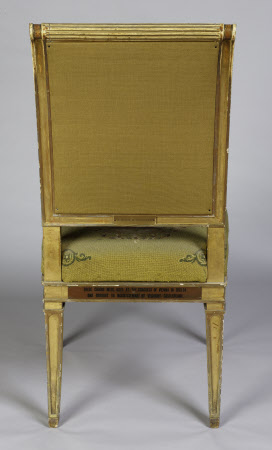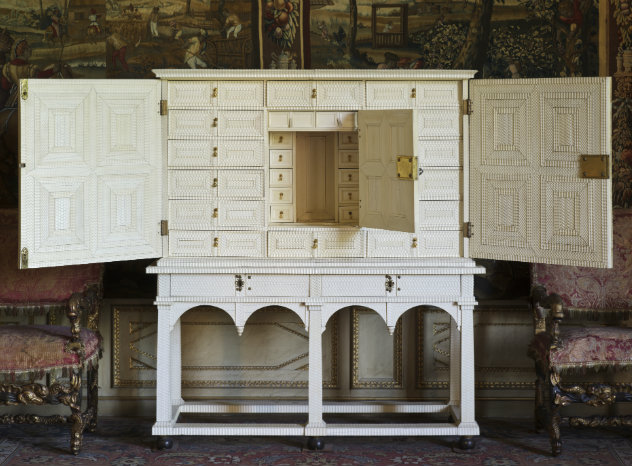The Congress of Vienna Chairs (Talleyrand)
probably Gregor Nutzinger
Category
Furniture
Date
circa 1814
Materials
Beech, gesso, gold leaf, linen, wool, silk, metal thread
Measurements
92.0 x 51.0 x 56.0 cm
Place of origin
Vienna
Order this imageCollection
Mount Stewart, County Down
NT 1220560.13
Summary
One of a set of twenty-two neo-classical chairs traditionally associated with the Congress of Vienna, 1814-15 (NT 1220560.1-22), two of which are later additions made in 1933 (NT 1220560.15 and 1220560.17). All chairs are upholstered and covered with pale yellow wool with silk embroidery, delineating the coat-of-arms of each of the principal delegates to the Congress (on the back) paired with the country, which they represented (on the seat). The present one bears the arms of Charles Maurice, prince de Talleyrand-Périgord (1754-1838), principal representative of France during the Congress of Vienna. A brass plaque at the back of this chair reads: ‘THESE CHAIRS WERE USED AT THE CONGRESS OF VIENNA IN 1813-14 [sic] AND BROUGHT TO MOUNT STEWART BY VISCOUNT CASTLEREAGH’.
Full description
One of a set of twenty-two neo-classical chairs traditionally associated with the Congress of Vienna, 1814-15 (NT 1220560.1-22), two of which are later additions made in 1933 (NT 1220560.15 and 1220560.17). All chairs are upholstered and covered with pale yellow wool with silk embroidery, delineating the coat-of-arms of each of the principal delegates to the Congress (on the back) paired with the country, which they represented (on the seat). The present one bears the arms of Charles Maurice, prince de Talleyrand-Périgord (1754-1838), principal representative of France during the Congress of Vienna. A brass plaque at the back of this chair reads: ‘THESE CHAIRS WERE USED AT THE CONGRESS OF VIENNA IN 1813-14 [sic] AND BROUGHT TO MOUNT STEWART BY VISCOUNT CASTLEREAGH’. The beech frames of the original chairs are gessoed and covered with gold leaf, the gilding being burnished on the raised elements and left matt elsewhere, while the two copies, made of birch, were decorated with bronze paint. In addition, two matching armchairs were also made in 1933, one with the Londonderry arms (NT 1220582) and one with those of Prime Minister Ramsay MacDonald. Although according to family tradition the chairs were a gift to Viscount Castlereagh, British Foreign Secretary at the Congress, it remains unclear whether they were part of the furniture supplied to the Imperial palaces and the Chancellery for the Congress, of, if in fact they were directly acquired by Castlereagh or his brother, Lord Stewart, British Ambassador to the Austrian Empire, for entertainment at the British Embassy at Palais Starhemberg. The Mount Stewart chairs are certainly very similar in design and proportions to a set supplied for the Audience Chamber of Empress Caroline Augusta, fourth wife of Emperor Francis I of Austria, in 1816 (Hofmobiliendepot, Vienna). Both the Imperial chair-maker Gregor Nutzinger and the upholsterer Michael Remele are likely candidates to be the authors of the chairs of the Empress, and indeed those at Mount Stewart. During extensive conservation work carried out on the set in 2015-16, two back and seat panels were found, as well as small fragments and threads of malachite green silk were found attached to some of the upholstery nails, indicating the colour of the original top covers. The original plain herringbone-ribbed Green silk was found on the chairs of Wessenberg and Stackelberg (NT 1220560.16 and 1220560.18), a plane Green silk seat on the chair with the arms of Castlereagh (1220560.8) as well as a later green damask on those of the marqués de Labrador (NT 1220560.21) and Prince Metternich (NT 1220560.1). It was Edith Vane-Tempest-Stewart, wife of the 7th Marquess of Londonderry, who around 1930 decided to recover the Congress of Vienna chairs with the arms of the delegates as depicted in the famous print after Isabey (NT 1220029). According to family tradition, the needlework was thought to have been carried out by nuns in Nantes, France, famous for their fine clerical embroideries. An almost complete set of invoices exists at the Public Record Office of Northern Ireland (PRONI), which reveals that Monsieur L. Legros (‘Broderies d’Art, Reproductions et Réparations d’Ancien’) oversaw the production of the new seat covers. Based in Nantes, Legros’s workshop may well have collaborated with the local order of the Visitation Sainte Marie de Nantes. To assist posterity in identifying, which arms belonged to which delegate, Lady Londonderry commissioned labels from E. L. Lehmann of 116 Wigmore Street, London, which were to be attached to the back seat rail of each chair. The labels follow the convention of Isabey’s print, which renders all surnames in combination with French styles and titles. In contrast to the print, however, the labels, such as they survive, are riddled with mistakes: ‘Comte Alexis de Noilles [sic]’, ‘Prince Matternich [sic]’, Baron de Wessemberg [sic]’, Prince Hardinberg [sic]’ and ‘Comte de Stackelburg [sic]’. On 22 June 1932, Lady Londonderry’s secretary wrote to Mr Lehmann, pointing out that there was ‘a mistake in the spelling of the table for Comte de Stackelburg’ and that she was ‘returning it for alteration.’ It is conceivable that Lehmann got it right in the first place. A comparable large suite of neo-classical gilt-wood chairs is at the château de Valencay, in the Loire Valley, embroidered by exiled ladies of the Spanish Court between 1808 and 1813, with a pattern of natural leaves found in the gardens surrounding the château. Valencay had belonged to Talleyrand and, rather like Mount Stewart, abounds in vestiges of the Congress of Vienna.
Provenance
Presented to the National Trust by Lady Mairi Bury (1921-2009) in 1976.
Credit line
(Entry adapted from Christopher Rowell and Wolf Burchard, ‘The British Embassy at Palais Starhemberg: Ambassadorial Furniture from the Congress of Vienna at Mount Stewart’, Furniture History, LII, 2017)
Marks and inscriptions
Makers and roles
probably Gregor Nutzinger, chairmaker probably Michael Remele, upholsterer L. Legros, upholsterer


